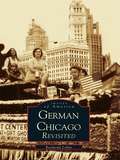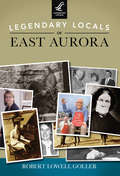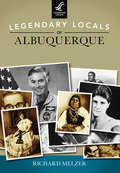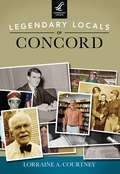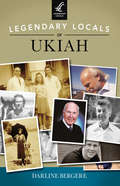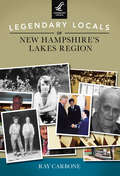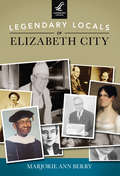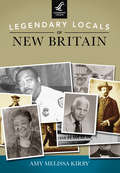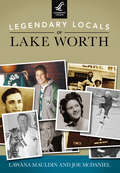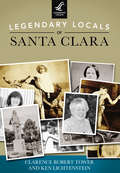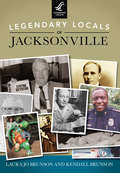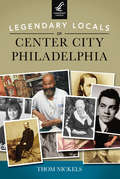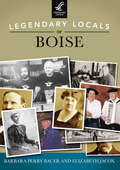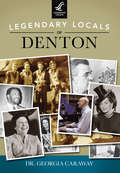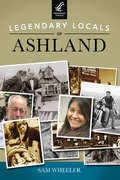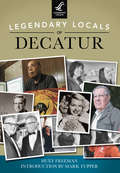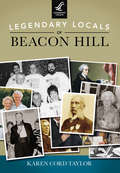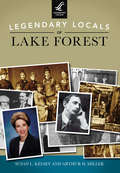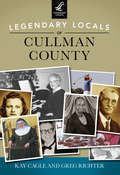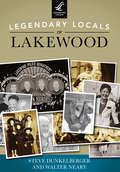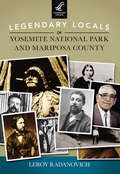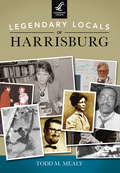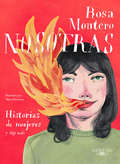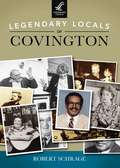- Table View
- List View
German Chicago: Revisited (Images of America)
by Raymond LohneGerman Chicago Revisited follows the photographic study which began in German Chicago: The Danube Swabians and the American Aid Societies. With this latest title in the Images of America series, historian and photographer Raymond Lohne crafts another volume about a group of American citizens who preserve their rich heritage with unwavering effort.This book will give readers a glimpse into the life of a close-knit and highly active community, revealing groups like the Kerneir Pleasure Club, the American Aid Society, and the Society of the Danube Swabians. The German musical life of the city is featured, as is the Karneval season and other year-round festivities and celebrations of the Deutsch-Americans of Chicago and its suburbs.
Legendary Locals of East Aurora (Legendary Locals)
by Robert Lowell GollerNestled along the banks of Cazenovia Creek, East Aurora is a cultural center of western New York State that has flourished because of the diverse talents of its people. Native Americans lived in East Aurora for thousands of years before the first settlers came to the area in 1804. One of the first pioneers, Martha Richardson Adams, carried her infant child on horseback all the way from Massachusetts. East Aurora grew rapidly after the War of 1812, evolving into an important business center south of Buffalo. By the 1880s, the village had become a horse-racing capital, where thousands came to Cicero Hamlin's farm to get a glimpse of his legendary horse, Mambrino King. As the century came to a close, hundreds of creative types were drawn to the Roycroft Campus, where Elbert Hubbard had established an arts and crafts colony. Despite modern developments, East Aurora remains a small village at heart, where the owners of the barbershop, bookstore, pharmacy, coffee shop, theater, and old-fashioned 5 & 10 still greet you at the door.
Legendary Locals of Albuquerque (Legendary Locals)
by Richard MelzerSpanish settlers founded Albuquerque in 1706, making it the third of only four villas (towns) in colonial New Mexico. Located in the Rio Abajo along a wide turn on the Rio Grande, the settlement developed from a small farming community into New Mexico's largest, most modern city. Many notable men and women participated in this remarkable growth, lending their talents and sacrificing their time, energy, and sometimes their very lives. Dozens of these legendary figures are portrayed in this unique book, with chapters devoted to those who played important roles in politics and diplomacy; the military; law and order; religion and education; art and literature; culture and entertainment; business and tourism; health, science, technology, and space; and sports. A final chapter describes several of Albuquerque's sung and unsung heroes. The result is a collage of a Western city filled with diversity, tradition, and cultural pride.
Legendary Locals of Concord (Legendary Locals)
by Lorraine A. CourtneyThe land now called Concord was originally inhabited by the Abenaki people and the Penacook tribe. Concord's first settlers, such as Ebenezer Eastman, began laying out the Plantation of Penacook, as it was known in 1725, along the fertile fields of the Merrimack River. It was incorporated in 1734 as Rumford and then renamed to Concord by Gov. Benning Wentworth in 1765. Concord experienced a surge in transportation and manufacturing in the 19th century, producing the Concord Coaches, Prescott Pianos, and steam boilers. As Concord celebrates its 250th anniversary, the city flourishes as the state capital and has a thriving community of restaurants, entertainment, and culture for all to enjoy. It retains its town sensibility as it plans for the continued growth of the local economy. Today's civic leaders, like Byron Champlin and James Carroll, work conjointly with business leaders, such as Tom Arnold of Arnie's and Juliana Eades of the New Hampshire Community Loan Fund, to build and enhance Concord's cultural, social, and economic identity.
Legendary Locals of Ukiah (Legendary Locals)
by Darline BergereMountains. Trees. A lake. What makes a city, town, or village come to life are the people--those who have gone before and those who are there today. They are what shape and build the community of Ukiah. With their personalities, foibles, compassion, and humor, some of these influential men and women stand out by design and some quietly exist on the sidelines. Utah Haley, a disabled veteran, drives other veterans to doctors' appointments. Rick Paige is always the first on-scene to help in a disaster. Spencer Brewer started the "Sundays in the Park" free concerts more than two decades ago. Ukiah is a town that supports its businesses, and those same local businesses give back to the community in many ways. Shannon Riley of Shoefly and Sox holds an annual shoe drive. Jan Hoyman and Doug Browe of Hoyman Browe Studios donate countless pieces of their work to charitable auctions. Ann Kilkenny of Mendocino Book Company gives time and assistance to local organizations. Marty Lombardi, who spent 40 years with Savings Bank of Mendocino, was always lending a helping hand to local nonprofits.
Legendary Locals of New Hampshire's Lakes Region (Legendary Locals)
by Ray CarboneThere are few places in America that have such a rich variety of landscape and scenery as the Lakes Region of New Hampshire: from the summer calm of Squam Lake to the robust white winter mountaintops of the Gunstock Mountain Resort. So it is no surprise that the people who call it home reflect the same wide palette of humankind--from the pre-Revolutionary War surveyors who first marked their initials on a rock at Weirs Beach to Bob Lawton, the current owner of the world's largest arcade; from one of George Washington's inner circle to Ernest Thompson, the award-winning author of On Golden Pond. The Lakes Region draws them--or grows them--all, because it has it all.
Legendary Locals of Elizabeth City (Legendary Locals)
by Marjorie Ann BerryElizabeth City is rich in legend and lore. The pirate Blackbeard was a frequent visitor to the area, selling his ill-gotten goods to a willing populace. The Wright brothers made Elizabeth City the first leg of their trips to Kitty Hawk, and they bought materials to build their flying machine from Kramer Brothers, a local lumberyard. Champion nine-ball player Luther "Wimpy" Lassiter was born and died here. Young "Beautiful Nell" Cropsey was murdered in 1901; her death is the town's most enduring mystery. Newspaperman W.O. Saunders, editor of the Independent, was known nationally after he walked down New York's Fifth Avenue in pajamas to protest uncomfortable work attire. Young Tamsen Donner, a member of the ill-fated Donner Party, was a teacher here in the 1830s. Fred Fearing's Rose Buddies welcomed boaters to Elizabeth City with homegrown roses and wine and cheese parties. He has entertained Walter Cronkite and Willard Scott, among other luminaries. These are just a few of the stories, mysteries, and legends of Elizabeth City's past and present.
Legendary Locals of New Britain (Legendary Locals)
by Amy Melissa KirbyNew Britain began in 1754 as an ecclesiastical society and farming village, and with few natural resources, was transformed into a modern industrial city by the time of its incorporation in 1871. Attracting waves of immigrant workers and entrepreneurs, this became a diverse but unified community in which people of all ethnicities worked together, served together in times of war, and even played together on the baseball fields. Legendary Locals of New Britain includes remarkable residents among the early inhabitants and settlers; the people and institutions that brought New Britain to cityhood; artists and entertainers; famous or leading immigrants; sports legends; and men and women who have otherwise made their mark on New Britain, the nation, or the world.
Legendary Locals of Lake Worth (Legendary Locals)
by Lawana Mauldin Joe McdanielDuring the early 1900s, a large reservoir built to provide water for Fort Worth, Texas, also opened up opportunities for businesses to develop. Casino Beach, Casino Ballroom, and a large bathhouse became popular spots for thousands. A nearby village, with increasing population, soon had a small school, churches, and other establishments. With nearby Jacksboro Highway running from downtown Fort Worth past the beach area, gambling increased, as did gangster activity. After a long while, with much intervention, these unlawful situations became history. Legendary Locals of Lake Worth spotlights the founders of the small village and features individuals who impacted the area--many for the better, others for the worst. Some may never have received proper recognition until this book's acknowledgment of them.
Legendary Locals of Santa Clara (Legendary Locals)
by Clarence Robert Tower Ken LichtensteinThe city of Santa Clara lies in the very heart of the Santa Clara Valley, directly south of San Francisco Bay. It is the home base of the internationally famous Santa Clara Swim Club, the equally famous synchronized swim team the Santa Clara Aquamaids, the International Swim Center, and the San Francisco 49ers professional football team. It boasts world-class parks, theaters, museums, acting groups, a featured chorale, a nationally ranked drum and bugle corps, a major theme park, a convention center, and a first-class hotel system for those who wish to visit. Legendary Locals of Santa Clara celebrates the people who guided all of this to its realization.
Legendary Locals of Jacksonville (Legendary Locals)
by Kendall Brunson Laura Jo BrunsonSince Europeans first settled along Jacksonville's riverbanks in the 16th century, the area has been a diverse community that thrives not only on commerce, music, and the arts but also on the advantages of a subtropical climate and waterside lifestyle. The city grew up around a crossing point for cattle in the St. Johns River and first became known as Cowford. The Great Fire of 1901 left 10,000 people homeless but not defeated. The ashes gave birth to a new era with strong architecture and a new resolve. Considered a friendly town for African Americans, Jacksonville was home to Harlem Renaissance artists as well as civil rights leaders. A bit laid back, the city has still managed to be on the cutting edge--it was the home of the Navy's Blue Angels as well as Southern rock and one of the country's first skateboard parks.
Legendary Locals of Center City Philadelphia (Legendary Locals)
by Thom NickelsPhiladelphia is a hard mistress when it comes to honoring native talent, and the city has more than its fair share of notable figures. Consider colorful politicians like Frank Rizzo and Richardson Dilworth, international celebrities like Grace Kelly, sports legends like Connie Mack, Philadelphia Museum of Art icons like Anne d'Harnoncourt, or national radio personalities like Terry Gross. Business tycoons such as John Wanamaker and Russell Conwell, founder of Temple University, made many contributions to the city. Pearl Buck, author of The Good Earth, and Christopher Morley, America's G.K. Chesterton, created legacies of their own. Other legends like the nearly forgotten Agnes Repplier, a world-famous essayist and contemporary of Henry James, and poet Daniel Hoffman, the designated US poet laureate in 1973-1974, have helped enrich the city's literary reputation. There are Marian Anderson, Mario Lanza, and Hollywood actor Kevin Bacon, whose fame is equaled by his city planner father, Edmund. Architects like Frank Furness, Louis Kahn, and Vincent Kling helped transform the city into an international destination. And there are many notables looming outside the margins of this book, waiting for their day of discovery.
Legendary Locals of Boise (Legendary Locals)
by Barbara Perry Bauer Elizabeth JacoxBoise of the 21st century is very different from the tiny community established in 1863 at the crossroads of the Oregon Trail and the road to the Boise Basin gold mines. Originally known as "Boise City," it existed as a distribution center for supplies and fresh food for miners. The development of irrigated agriculture and the expansion of transportation networks during the 20th century and an influx of pioneers from many regions of the United States helped the city grow into a technology center during the 21st century. Early residents like Tom and Julia Davis helped create a city filled with green parks and walking paths; author and illustrator Mary Hallock Foote brought Boise to the attention of the nation with her writing and illustrations; businessmen J.R. Simplot and Joe Albertson established local businesses that grew to national companies. The music of Curtis Stigers, the literature of Anthony Doerr, and the athletic prowess of Kristin Armstrong have helped focus attention on Boise, which is now recognized as one of the country's most livable communities.
Legendary Locals of Denton (Legendary Locals)
by Dr Georgia CarawayDenton, Texas, was founded in 1857 because residents needed a location near the geographic center of Denton County to house a county seat. The city is located 39 miles north of two larger cities, Dallas and Fort Worth, and the three of them form what is often referred to as the "Golden Triangle." Denton, the peak of that triangle, is the "North Star," and its residents, past and present, certainly are superstars--superstars such as Bob Rogers, the beloved "Piano Man;" Mary Evelyn Blagg Huey, a quintessential leader; and Hal Jackson, an ace war hero and lawyer. Their accomplishments burst forth from the chapters of this book to outshine others with their generosity, talents, skills, community activism, adventurous spirits, energy, civic pride, business acumen, courage, and creativity. Citizens of Denton are proud to say, "Our history defines our community." The images and words between these covers illustrate why it should be added, "And our people define our history."
Legendary Locals of Ashland (Legendary Locals)
by Sam WheelerA century and a half of close-knitted community spirit, independent-mindedness, and a strong sense of stewardship have uniquely melded into present-day Ashland. Behind that patchwork of local ingenuity, artistry, and infamy are the faces of thousands--too many of whom are not mentioned within the pages of this book. There were hundreds of generations of Shasta Native American families that lived off the hills and creeks where Ashland now sprawls, but their abodes were abandoned and replaced by the lumber and flour mills, cleared streets, and painted homes of Ashland Mills. The sense of spirit and enthusiasm instilled by Ashland's early settlers bred the town's participation in the Chautauqua cultural movement, the remnants of which harbor Ashland's world-renown Oregon Shakespeare Festival, which paved the way for a former mill town's future prosperity. That spirit of ingenuity and artistry continues to shape Ashland and attracts hundreds of thousands of visitors annually to the quaint town nestled below the mighty crest of Siskiyou Pass along the Oregon-California border.
Legendary Locals of Decatur (Legendary Locals)
by Huey Freeman Mark TupperA working-class city of 75,000 people on the banks of the Sangamon River and its largest lake, Decatur has a reputation for outstanding individuals with a strong community spirit and an unashamed sense of patriotism. To borrow a phrase from Adm. Chester Nimitz, in Decatur, uncommon dedication is a common virtue. Harold Miller fought at Iwo Jima with a Marine tank battalion, before serving 32 years on the Decatur Police Department. Wayne and Leslie Kent, ministers at First Christian Church, risked their freedom to bring music and encouragement to oppressed believers in the Soviet Union and Poland. George Halas, a Navy veteran, was player-coach for the Decatur Staleys football team (later the Chicago Bears), a charter franchise in the professional association that would become the NFL. Bob Fallstrom, a World War II soldier before working as a newspaper reporter and editor in Decatur for more than 65 years, has promoted numerous community causes. Legendary Locals of Decatur pays tribute to those who have made this community truly unique.
Legendary Locals of Beacon Hill (Legendary Locals)
by Karen Cord TaylorIn the 1600s, William Blaxton set up his farmstead on Beacon Hill because it was far from the bustle of the city. John Hancock's uncle Thomas Hancock built his mansion on the hill in the 1700s so he could enjoy a rural lifestyle. In the early 1800s, future mayor of Boston Harrison Gray Otis moved to Beacon Hill because it was the new and fashionable neighborhood he was helping create. Louisa May Alcott, in the 19th century, and Robert Frost, in the 20th, lived on the hill because the literary set loved the neighborhood's picturesque streets and close quarters that made it easy to get together for conversation. The 9,000 residents who live in this small, urban neighborhood of Boston today appreciate its walkability, convenience, quirkiness, and neighborliness. The historic architecture, ever-burning gas lamps, rugged bricks, and one-of-a-kind shops prove that the best of the past can live comfortably with the novelty of the present.
Legendary Locals of Lake Forest (Legendary Locals)
by Arthur H. Miller Susan L. KelseySince the 1850s, Lake Forest, located 30 miles north of Chicago on Lake Michigan, has been a distinctive suburb. It has been a retreat from the diseases, public accessibility, rougher elements, soot, stockyard smells, and general density of bustling city life. For at least five generations, it has been the retreat for Chicago's leading New England-descended families, such as the Farwells, Swifts, and Armours. And for over 150 years, Lake Forest has been the home for a community of educators, merchants, artisans, designers, and a wide variety of estate specialists, the latter from pre-Civil War escaped slaves and Scots and Irish immigrants to today's notable garden and interior artists. Legendary Locals of Lake Forest draws on rare archival images from local and Chicago public and private sources.
Legendary Locals of Cullman County (Legendary Locals)
by Greg Richter Kay CagleIn search of opportunity and freedom from oppression, European emigrants boarded ships, leaving behind their ancestral homes. They carved new lives from the unknown wilderness in the American South. The Speegle family settled in what would become southwest Cullman County, and the Brindley family claimed lands to the north. From the historic Streight's Raid exploit of the Civil War to the agricultural and social development of this region of northern Alabama, these early pioneers marched into history. In 1865, Col. Johann G. Cullmann, who was disillusioned with the anarchism in his native Germany, also sought new opportunity in America, eventually settling in Alabama. After being enticed by Colonel Cullmann's descriptive words of the area's virgin timber and fertile soils, ?ve German families joined him. Encouraged by what they found, optimism flourished, word spread, and Cullman County's destiny was set. Its growth has been constant, and, today, its expansion is propelling the area to new heights of economic prominence.
Legendary Locals of Lakewood (Legendary Locals)
by Walter Neary Steve DunkelbergerLakewood was a vibrant community long before it incorporated in 1996, though cityhood helped give the area one name and identity. In the mid-19th century, Lakewood was the site of British farms and the first US military base in Washington Territory. Men who became famous in the Civil War, such as George Pickett, served there. Native American leader Leschi, the victim of "judicial lynching" by civilians, spent his last days there. As Lakewood became a retreat for Puget Sound's rich and famous, names such as Carman and Alexander--as famous in their day as the name Weyerhaeuser was and is--settled here, leaving behind reminders like Lakewold Gardens. One of Lakewood's most famous residents was Ivan, a captive gorilla who captured the hearts of animal lovers worldwide.
Legendary Locals of Yosemite National Park and Mariposa County (Legendary Locals)
by Leroy RadanovichIn 1846, Thomas Larkin, American council general to the Mexican government in California, purchased a Mexican land grant, Las Mariposas, for Col. John C. Fremont. The grant consisted of 10 square leagues of grazing land located near the Merced River and west of the Sierra. In 1848, when California became the possession of the United States, the treaty called for the recognition of preexisting grants. Gold was discovered in the foothills of the Sierra that same year. Fremont floated his questionable Mexican grant into the gold discovery region. With the formation of the State of California in 1850, one of the original counties was named Mariposa, Spanish for "butterflies." Located within the county was the Fremont grant and much of the yet undiscovered Yosemite region of the Sierra. Encounters with Native Americans near the mining camps lead to the formation of the Mariposa Battalion, and a search for the natives led to the American discovery of Yosemite Valley. Thus, it was custodians and photographers such as Charles Leander Weed, Carlton E Watkins, J.J. Riley, George Fiske, Ansel Adams, and many others that interpreted and introduced Yosemite to the world.
Legendary Locals of Harrisburg (Legendary Locals)
by Todd M. MealyWith images taken from the archives of the Dauphin County Historical Society, as well as family collections, Legendary Locals of Harrisburg encompasses biographical tributes that celebrate the deeds of actors, musicians, artists, teachers, athletes, humanitarians, politicians, veterans, firemen, and community leaders who have added a peculiar brand of Harrisburg's rich cultural tapestry. William Howard Day, an educator, and John Harris, who established Harrisburg, are two pioneers. Edward Stackpole, of Stackpole Books, and Theophilus Fenn, editor of the Telegraph, have forged the way for the city's writers. The first secretary of homeland security, Tom Ridge, and Simon Cameron, secretary of war under Lincoln, are among world-renowned politicians who have contributed to Harrisburg's valued reputation. From rival high school football coaches to dueling business owners, from civic leaders building an integrated city to aspiring young people embarking on independent journeys to the big screen, these profiles of real lives and real heroes show us that we all have contributed to the development of our own communities.
Nosotras. Historias de mujeres y algo más
by Rosa MonteroEdición especial de uno de los libros fundamentales de Rosa Montero, Premio Nacional de las Letras 2017. Una obra pionera en la reivindicación del papel de la mujer en la historia a través de las biografías de sus protagonistas. Ilustrada por María Herreros. Escúchalo ahora «Este libro no es un libro solo para mujeres, de la misma manera que el feminismo no es solo cosa de chicas. Estamos cambiando el mundo, estamos destruyendo estereotipos milenarios, y es evidente que si se altera el papel social femenino, es porque también muda el papel de los hombres. »Incluye el texto original de Historias de mujeres, publicado hace veinticuatro años, y añade noventa nuevos pequeños retratos, una ojeada rápida desde la antigüedad hasta nuestros días que nos permite atisbar la compleja riqueza de la aportación femenina a la vida común. Porque hay una historia que no está enla historia y que solo se puede rescatar aguzando el oído y escuchando el susurro de las mujeres. La porción invisible del iceberg de protagonistas silenciadas empieza a emerger ahora, y tiene unas dimensiones colosales. Ha habido mujeres en todas las épocas haciendo cosas memorables. No hay un solo campo social, artístico o del conocimiento en el que no hayamos destacado. Y se trata de un pasado que nos han robado a todos. »Pero tenemos que hacer algo más que cambiar la visión del pasado: es esencial que también cambiemos la visión del presente. La manera en que nos miramos a nosotras mismas. El mundo, nos decían y nos decíamos, es así. Pero no. Resulta que el mundo no es así. El futuro está aquí, el futuro es hoy y lo estamos construyendo hombres y mujeres. Por primera vez estamos todos. Aunque, para ello, también debamos abandonar nosotras muchos prejuicios sexistas. Así es que, hermanas, abramos nuestras fauces de dragonas y escupamos fuego.»Rosa Montero --------------------------------- La crítica ha dicho sobre Historias de mujeres...«Escribe con el punto casi exacto de acercamiento, con sinceridad y ardor pero sin concesiones fáciles, sabedora de que sus heroínas sufrieron a causa del entorno todo, y no solo de los hombres. Desde esta óptica madura y razonable, la prosa de Montero se nos hace así paradójicamente intensa, creíble, verdadera.»Miguel Dalmau, La Vanguardia «No perseguía un documento de hazañas femeninas ejemplares, solo ejemplos de mujeres que se atrevieron a traicionar las expectativas que la sociedad, durante siglos, depositó en ellas y asaltaron con audacias inéditas los preceptos que asignaban sus funciones.»Pilar Castro, ABC «El deseo de equilibrio entre los sexos late como un pulso en todo el libro de Montero. El mismo deseo que anima los modos de sentir y pensar de una mujer que ansía, en cada lugar, por oscuro y difícil que sea, ver llegar el fin de la prohibición, el día en que cada una pueda modelar su propia forma como un regalo que no temerá.»Teresa Hernández, Diario 16 Andalucía «Una parte de la historia clandestina de las mujeres y sus esfuerzos, muchas veces trágicos, para liberarse de la norma social masculina.»Andrés Fernández Rubio, El País «Interesante muestra, no solo de lo que el género biográfico puede dar de sí abordado con pasión y oficio, también de lo que las mujeres han aportado a la historia o a sus recovecos desde el matrimonio o la rebeldía.»Care Santos, El Cultural «Mujeres que dejaron huella, que hicieron historia. [...] Mujeres con vida propia.»El Tiempo «Queda claro que Rosa Montero, como ella misma resalta, no ha pretendido sublimar la figura de la mujer, ni exaltar a heroínas o señalar víctimas y victimarios, sino mostrar "la humanidad cabal y plena, con todas sus luces y sus sombras", demuj
Legendary Locals of Covington (Legendary Locals)
by Robert SchrageCovington was a natural place for people to settle. Located on the banks of the Ohio and Licking Rivers, it developed quickly as the urban core of northern Kentucky. Sitting just opposite of Cincinnati, Ohio, it was a great location for travel by both animals and people. Originally owned by Thomas Kennedy, the land was ultimately purchased by Thomas Carneal and John and Richard Gano, and thus the city of Covington was founded in 1815. Not long after its establishment, railroads made Covington their home and many other businesses followed. By 1850, it was the second-largest city in Kentucky. Over its 200 years, Covington has seen many people play a role in its history, development, and reputation. Some are great business and community leaders. Others made tremendous contributions to the arts, and some are notorious. A community is defined more by its people than its buildings and streets. The individuals who have lived and worked in Covington provide a colorful insight into its past. From its founding until the present day, these individuals are a fascinating look into the city's history.
School Choice: A Legacy to Keep
by Virginia Walden FordOn a cold winter night in February of 1967, a large rock shattered a bedroom window in Virginia Walden Ford's home in Little Rock, Arkansas, landing in her baby sister's crib. Outside, members of the Ku Klux Klan burned a cross on her family's lawn. Faceless bigots were terrorizing Virginia, her parents, and her sisters–all because her father, Harry Fowler, dared to take a job as the assistant superintendent of personnel for the Little Rock School District. He was more than qualified, but he was black.In her searing new memoir, legendary school choice advocate Virginia Walden Ford recounts the lessons she learned as a child in the segregated south. She drew on those experiences—and the legacies handed to her by her parents and ancestors—thirty years later, when she built an army of parents to fight for school choice in our nation's capital. School Choice: A Legacy to Keep, tells the dramatic true story of how poor D.C. parents, with the support of unlikely allies, faced off against some of America's most prominent politicians—and won a better future for children.
